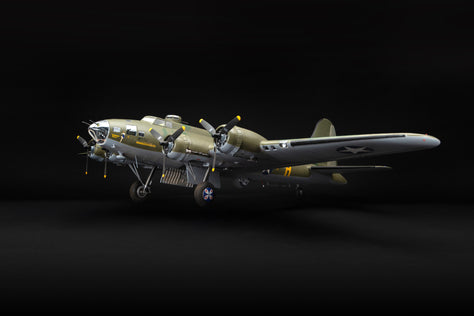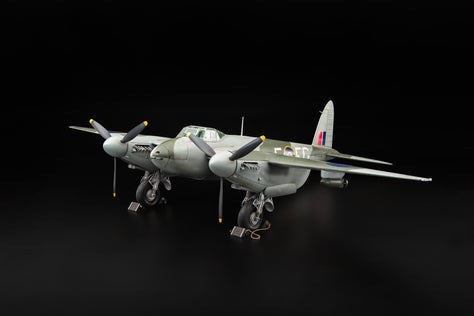Technical Details
- Description
- Scale guide
Only one model remains in this edition.
We are delighted to introduce a new weathered project at 1:8 scale: a special Limited Edition of five artistically race weathered models of the Mercedes-Benz W196 Monoposto as raced to victory in the 1955 British Grand Prix by Sir Stirling Moss. The weathering details are precisely applied by our artisans using archival imagery to ensure the completed model is a perfect replica of the real car as it finished the race in 1955. Each model is accompanied by an archive quality Giclée print of the car as it crossed the line, selected by Amalgam from the Motorsport Images collection. The artistry applied to these five models underlines our commitment to creating beautiful hand-made pieces which fully capture both the spirit and precise appearance of iconic race cars.
One of the most dominant cars to have ever raced at the pinnacle of motorsport, the Mercedes-Benz W196 drove its competitors to despair during the 1954 and 1955 Formula 1 seasons in which it was entered, capturing the only two World Championships in which it competed.
Mercedes had been absent in Grand Prix racing for twenty years, but a combination of new Formula 1 regulations and a thriving economic turnaround in Germany allowed the Silver Arrows to compete once again. Expectations were high; in the past the Mercedes-Benz racing cars were not only the fastest, but also the most technologically advanced; a showcase of the company's advanced technical capabilities. The W196 did not disappoint. Considering the relatively small displacement of 2.5 litres, the team of engineers, headed by Fritz Nallinger and Rudolf Uhlenhautand, chose a surprising and different format for the long straight eight engine, though this risk soon yielded astonishing results.
The W196 was the first Formula 1 car to use desmodromic valves to allow the significantly smaller engine to rev higher, as well as the first to use a Bosch-developed fuel injection system, which had already been successfully used on the 300SL racing cars. Adapted from the DB 601 high-performance V12 used on the Messerschmitt Bf 109E fighter, the novel fuel injection system allowed for 257 brake horsepower at the time of its debut, rising to 290 bhp at an impressive 8500 rpm after a year of on-track development. Also carried over from the 300SL was the space-frame chassis, which featured an entirely new approach to chassis building, combining light weight with exceptional rigidity. Sparing no expense, the engineers developed a variety of track specific versions of the W196 with three wheelbases and two interchangeable body styles: the ‘Type Monza’ low-drag streamliner body, designed for high-speed circuits, and the more open-wheel configuration, for the more technical, twisty circuits.
Still busy developing the cars, Mercedes missed the first three races of the 1954 season; the belated debut came at the French Grand Prix in Reims, where the streamlined body was immediately right at home. Racing manager Alfred Neubauer hired the – initially reluctant – superstar Juan Manuel Fangio to partner the German duo of Hans Herrmann and Karl Kling, and it was instantly obvious that the German marque’s approach was too much for the Italian and British specialist manufacturers to match. Fangio helped Mercedes to continue a debut-winning tradition by piloting the W196 to a debut victory, a few metres ahead of Kling, whilst Herrmann posted the fastest lap. The open-wheel variant of the W196 debuted two races later in the team’s home Grand Prix at the Nürburgring, after a tougher race at Silverstone. Fangio again was victorious, and would go on to dominate three races in a row, winning at the Swiss and Italian Grands Prix as well. In a relatively poor showing in the final race in Spain, the Argentinian claimed a podium as he finished the season as the World Champion. While Fangio started the season at Alfa Romeo, winning two races with the Italians, his points tally with the W196 alone would have been enough to win him the World Championship title.
For 1955, Fangio was joined by a new team-mate, the up-and-coming Stirling Moss, creating a virtually invincible pairing. The Argentine driver started the season on a high by winning his home Grand Prix in soaring temperatures that exhausted most of his opponents. The W196’s lowest moment followed, as it failed to score a single point at Monaco: all three of the entered cars were hampered by reliability problems. Despite the horrifying 1955 Le Mans disaster shortening the Formula 1 season, the W196 completely dominated the remaining four races, finishing first and second in Belgium (Fangio-Moss), the Netherlands (Fangio-Moss) and Italy (Fangio-Taruffi), whilst at the penultimate race in Great Britain, the Mercedes team took a remarkable 1-2-3-4, Moss claiming his first Grand Prix victory ahead of Fangio, Kling and Piero Taruffi. Needless to say, Fangio was crowned champion again with Moss a distant second.
Shaken by the Le Mans accident, Mercedes-Benz left Grand Prix racing at the end of the season for the third time in their history, retiring their almost invincible car after racing for just one year and two months. Overall, the versatile W196's track record was impressive indeed: nine victories, eight pole positions and nine fastest laps in the twelve Grand Prix races in which it was entered, and, of course, Fangio's world titles in 1954 and 1955. It is widely agreed that the only reason the W196 did not win more titles is that the Manufacturers’ Championship was not introduced until 1958.
The race weathered Mercedes-Benz W196 Monoposto is limited to just 5 pieces.
Handling Race Weathered Models
Please note that Amalgam’s weathered models are incredibly fragile and require careful handling. We recommend you keep handling to a minimum to avoid removing the weathered effects from the model. When handling the model, please adhere to the instructions included with the product when purchased. The brush featured in the gallery is included purely for demonstrating the scale of the model. We do not advise any cleaning of our weathered models as this may remove some of the weathering applications.
--------------------------------------------------------------Elevate your 1:8 scale collection with one of our elegant, harmonious and handcrafted display cabinets, stands or plinths.
Pre-order
Bespoke
In order for us to create your bespoke model, you will need to choose 4 extra options. Paint colour, interior colour, wheel style and caliper colour.
Please complete the form and a member of our Sales Team will contact you.
Contact Us
Please contact us for more information about ordering this model.


![[hide-in-gallery]](http://www.amalgamcollection.com/cdn/shop/products/M5033-MON-68-MercedesW196Monoposto1.8ScaleWeathered-Front3.4WIDEEDIT_2000x850_crop_center.jpg?v=1608309383)



